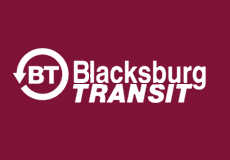
The Problem / Challenge
- Did not use electronic fare boxes
The Solution
- Bus density, location, amd adherence to schedule
The Result
BT’s reliable and punctual service
About Blacksburg Transit (BT)
Blacksburg Transit is a local government-owned, urban/suburban bus line. Centered in Blacksburg, Virginia, they are proud to provide safe, courteous, reliable, accessible and affordable public transportation to a variety of communities. Over the years it has grown from a six-bus operation (in 1983) to the contemporary version we see today, comprised of 50 buses and 11 vans. They deal in both fixed route transit operation as well as offering student shuttle and DR paratransit services. But the main focus of their agency is in transporting large amounts of riders to Virginia Tech as well as other local citizens. Being able to handle rider density is a daunting task, especially when their ridership needs extra attention when it comes to adhering to a predictable time table.
Of the 2,950,000 riders per year, students account for 90%: all of whom have very strict schedules and obligations as you can imagine. So the need for reliability and being on time was of utmost concern to both the riders and to the agency responsible for scheduling and planning bus routes.
The Problem / Challenge
Density and rider counting were the main problems. It was incredibly hard to determine exactly which buses were overflowing capacity and which ones were going under ridden. BT knew that this info could help to improve their services, if only they could collect it. The added problem they faced was the fact that their buses did not use electronic fare boxes. This led the BT to determine that fixed route software with automated rider counting capacity was needed in order to get a clearer and more accurate picture of their operation. For example, how many students versus faculty, staff and citizens were using their system? Knowing these pieces of info could allow BT to determine where their buses should be, depending upon ridership and time of day. They needed to share valuable rider data with Virginia Tech, but they couldn’t.
“What we needed from a CAD/AVL system was better data collection”
On top of bus density was the issue that faced their dispatchers. Saddled with a great deal of paperwork for information management purposes, dispatcher time wasn’t being used to optimal amounts. With attention focused on spreadsheets, valuable time and resources are drawn away from areas such as customer complaints and calls.
Fixed Route Transportation Software Solution
TripSpark’s software along with CAD/AVL (Computer Aided Dispatch/Automatic Vehicle Location) technologies was implemented in order to automate the dispatching of vehicles and facilitate the collection of rider data. This allowed BT to track vehicles in real time, get an extremely clear picture of ridership. The drivers were given the ability to contact dispatchers wirelessly in order pass relevant and important information regarding schedule timing and adherence.
“This allows us to determine where the buses should be.”
We replaced traditional paper work with a digital data collection solution that allowed them to generate instant reports on who was taking the bus at any given time. TripSpark’s fixed route transportation solution gave dispatchers a user-friendly view of vehicle data such as: bus density, location and adherence to schedule.
The Result
Now that BT can automatically generate fare reports, dealing with the University is far less complicated. They were able to count heads, finally, and alter bus schedules to accommodate the new data. No more over-flowing or under-flowing buses. Customer complaints and calls can now be addressed much quicker. As well, having access to real time bus info allows call takers to transmit schedule updates faster to callers. These changes have helped to build confidence in BT’s reliable and punctual service.
“Everybody is facing tighter budgets.”
Costs can be managed more easily because funds can be sent to where they’re needed most. Drivers and dispatchers aren’t spending time in areas that are unproductive. In fact, everyone benefits from a transit agency that has:
- Improved information management
- Rider satisfaction
- Elimination of paperwork
TripSpark was able to work within BT’s budgetary demands and was still able to provide a service that improved operational productivity. And as they continue to grow, our dedicated team of service and sales specialists will be there, every bus stop along the way.
With access to accurate headcounts, Blacksburg Transit was able to re-allocate buses and resources to where they served the most benefit to their operation, their staff and their riders.
